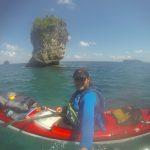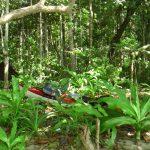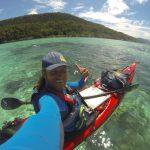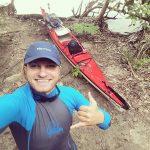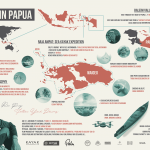Raja Ampat is an archipelago of islands located on the north side of the island of Papua, the second largest island in the world. There are more than 1,500 islands and islets, mostly uninhabited, between crystalline waters, palm trees and an abundant underwater life.
I’ve been paddling alone with a sea kayak those wonderful waters for thirty days and more than 600 kilometres. In particular, I have circumnavigated the great island of Waigeo, the largest and most varied of the Raja Ampat archipelago, a route that had never been done before. It has been much harder than expected, especially the north coast of the island, with strong waves breaking above the coral reef, long crossings to the open sea and intense heat and tropical storms. In contrast the south and west of the island are transparent and calm waters between an idyllic landscape.
I have a documentary edited by a producer about my expedition. It’s called Solo in Papua. I’m projecting it in many clubs, schools or film festivals. If you are interested in watching it, please contact me. And more information (in Spanish) here.
When to go
I went in December and January, the best time for the winds, but also the most touristy. However, compared to other parts of the world, there are still relatively few people. From November to March is the good time and when the sea water is clearer for snorkelling or scuba diving.
Local help
My expedition would not have been successful without the help of Kayak4Conservation, those who provided me with the sea kayak and a lot of information about the area, especially with the help of the pioneer Max Ammer. They offer basically guided tours by local guides. In my case they let me to rent my own sea kayak due to my demonstrable experience. Also, there are several fishing villages, where the people, despite not speaking English, are very friendly and hospitable. There are more tourist resorts with all the logistics and comfort for travellers, all located to the south coast.
Food and drink
In the villages there are no supermarkets, only in the capital of Waigeo Island. If you stay in a lodge, they offer you all the meals and necessities. But if you go on an expedition with the kayak, make sure that the company has organized the meals in the many home stays that are in the villages. If you leave the south coast, you will have to do all the shopping in Sorong, the gateway city to Raja Ampat. Water is a problem because you do not always find bottled waters, so make sure you can store a lot of drinkable water in your kayak
Accommodation
In the many lodges they offer accommodation in wooden cabins with different types of comfort. It must be said, Raja Ampat is the most expensive part of Indonesia. Camping on the islands is allowed but it is not easy to do it. There are few beaches at high tide, there is a lot of impenetrable jungle and there are many insects. I recommend bringing a hammock tent to be isolated from the ground.
Transport
To get to Raja Ampat you have to fly to the city of Sorong and from there take one of the daily ferries to Waisai, the capital and the island of Waigeo. From Waisai you have to previously book a water taxi that takes you to one of the many lodges. The lodge offer this transfer normally. You have to pay a tourist tax of about 80/90 € to access Raja Ampat once you are in Waisai.
Quickfire rules for sea kayaking in Raja Ampat
– Get ready for strong heat
Heat and humidity are extremely high, make sure your kayak has a lot of load capacity to store much bottled water, and hydrate a lot. Paddling 20 km there is like 30 km in Europe. Take good clothes for this climate and by the way, do not carry a sleeping bag, you do not need one!
– Do not forget a snorkel gear but watch out!
Snorkelling there is impressive: coral of many colours, tropical fish, giant blankets, turtles, reef sharks … but there are saltwater crocodiles and extreme precautions must be taken. Do not do it in the mangrove area or alone.
– Bring your food for the expedition
Although there are villages and they will offer you food (rice and more rice!), I recommend that you bring more food that you like. You can make a great purchase in Sorong or bring freeze-dried food from home. In the lodges they offer European food but it is very expensive.
– Bring mosquito repellent and a good first aid kit
Take a repellent for tropical environments and make sure you bring medication for several cases. In my case I was medicated every day for malaria.
– There is not much information on the internet
I recommend you ask the company Kayak4Conseration and let yourself be advised by them. I can also answer some of your questions . Anyways not all your question will answered till you are there. You have to think Papua is Papua, nobody know what will happens for sure.
– Routes of three to seven days by the south coast are relatively accessible.
I recommend doing a week-long route with a local guide, so you will learn from their local knowledge and they take you snorkelling in the best secret spots. They are not technically very experts but going with them is an added value. Only for the most experienced kayakers and ‘crazy like me’ can go alone by those waters. It seems easy, but it is not, there are many currents, dangerous animals and you can get lost between islands. There is no emergency logistics if an accident happens.
– North coast, islands of Wayag and Coesta East, wild and dangerous.
It’s probably the most dangerous thing I’ve done in my life with a kayak, but also one of my biggest adventures. Inaccessible, long, exposed, remote and full of dangers. I do not recommend kayaking around, unless you are a group of expert paddlers.
